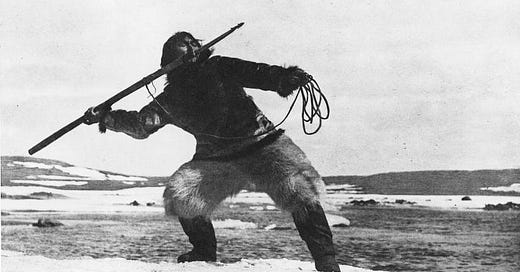NEW ALL-TOO-TRUE-BLUE STATE HISTORIES (ALASKA)
Excerpt from “The New All-too-True-Blue History of ALASKA”
TIME IMMEMORIAL – Mastodons and Kodak Bears
The first critters in Alaska were Mastodons and Kodak Bears. The Kodak Bears were then called “Brownies,” though.
The first human on the scene there was Nanook the Eskimo. He had a pet baby seal that he doted on to the point where he stole margarine from a pancake breakfast in order to spoil his flippered friend.
The second human on the scene was St. Alfonzo, a Russian who crossed the Bering land bridge (built by the army corps of engineers) with the express purpose of hosting pancake breakfasts for the indigenous peoples and their hippie friends (people with large hips).
A certain coolness manifested itself between these two gents (Nanook and St. Alfonzo) once the margarine pilfering by the party of the first part came to light.
Other Russians followed Alfonzo, and in time there were a fair number of these vodkaheads in Alaska.
Here is what Nanook was reduced to doing to try to scare up some vittles (vain attempts to harpoon eagles as they fly by) when no pancake breakfasts were being served up:
1493 – Spain Claims Alaska
In 1493, apparently feeling their oats because of the extravagant showboating of Christopher Columbus the year before, Spain claimed Alaska for itself. The pope said they owned it, but that was just bull.
In this particular case, it was bull that pope Rural perpetrated:
1728 – Bering Goes Strait
The most famous Russian of them all was Vitus Bering. He gained this notoriety due to being the founder and first president of E. Clampus Vitus, an illustrious organization which took its name from him, their patron saint.
Not one to rest on his laurels, in 1728 Vitus Bering was in Alaska looking for a Danish (or, better yet, a Cinnamon Roll), and discovered instead a Strait.
A strait is no good without a corresponding jacket – except when you’re in Dire Straits, which he was, along with his copilot Mark Knopfler.
Note: A straight, on the other hand, can be a good thing to have when you’re playing poker.In this Polaroid taken by a stowaway, Bering is seen pointing at an iceberg he wants to ram, and Knopfler is using a spyglass in an attempt to locate a Chick-Fil-A restaurant, as he has a coupon for a free sandwich there:
1778 – Captain Cook Discovers an Inlet
In 1778, in a vain attempt to distract attention from the revolutionary antics going on in the American colonies, Captain James “Jimmy Boy” Cook claimed to discover an inlet near an anchorage in Alaska.
Unfortunately for him, he also discovered the outlet, and so eventually sailed on to Hawaii, where he perished from an ill-advised sandwich overdose.
It was to be expected that Cook would terminate his course in some odd fashion, because he was quite an addle-brained individual. You can see that by the topsy-turvy, squirrelly path described by his ships, as seen in the police sketch below, provided by his cook, a Mr. Captain (Captain Cook was the ship’s captain, and Cook Captain was the ship’s cook).
In the blue line, you can see that, after a loop-de-loop around Polynesia (he thought he saw something, and went back to look), Cook headed to Alaska.
Every time Cook told his steersman to turn, he would soon change his mind and say, “Turn again!” He did this so often that some of his crew got motion sickness from the constant turning business. Some even wanted to mutiny as a result of the monotony of it all.
1867 – Alaska Purchase
Two years after the Civil War, bored with the relative calm, William Seward bought Alaska from the Russians for $7.2 million dollars. The fact that the price worked out to two cents per acre shows just how many acres were involved. A lot!
Yet, some referred to this outlay as “Seward’s Folly”, “Seward’s Icebox” and “Andrew Johnson’s Polar Bear Garden.”
For the humans living in Alaska (the polar bears didn’t care), the change from Russian rule brought with it a change from the Julian to the Greggorian calendar.
The Julian calendar was named for Julian Lennon. The Greggorian calendar was named for Forrest Gregg, a former Green Bay Packer player and coach who was renowned for always being early to meetings and practice, lending logic to the christening of his internal clock as the “Greggorian Calendar.”
Thus, when this change took effect (when Seward forked over the cool seven point two million to Ivan the Terrible), Alaskans who had thought it was October 7th (which was logical, because the previous day for them had been October 6th) found -- much to their chagrin, dismay, and general head scratching -- that it was actually October 18th. At least it was still Friday, though, so they didn’t miss out on their weekend.
Note: Although he was a Secretary, Mr. Seward seldom, if ever, wore panty hose, lipstick, or high-heeled shoes.Here is the check that Secretary Seward faxed to Mr. Terrible:
. . .
The complete book “The New All-too-True-Blue History of Alaska” is available here.
Each Wednesday an excerpt of one State’s (parodied) history will be posted here, in alphabetical order (from Alabama to Wyoming).
You can listen to this excerpt here:
Blackbird Crow Raven is also the author of the book “the Zany Time Travels of Warble McGorkle”








